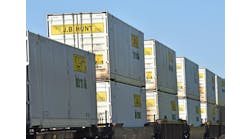In my spare time, I’ve been writing a screenplay. Since we’ve just passed through another graduation season, I think this should play well, especially with younger movie goers. My working title is, The Pallet.
The setting: a dinner party with particularly wealthy people. A young woman, freshly out of college and acting like a lost ball in the high weeds, is approached by a portly gentleman. He leans over and whispers in her ear: “I just want to say one word to you—just one word. Plastics.” She turns to him, confusion and concern on her face, and says, “But, I want to be different.”
I’ve had a lot of help with sorting out the plot and characters for this epic. Sources say to make it a classic struggle between paper and plastic—or in this case, wood versus every other material. And, the protagonist has to be sustainability. Or, is sustainability the antagonist? Whatever.
I recently had the pleasure of moderat ing a ses s ion on mater ial handling at the Greening of the Supply Chain conference. One of the panelists, Tim Smith of CHEP, presented one of the better cases I’ve heard for sustainability and wood pallets. In truth, he was material neutral. His quite-valid point was that pallet pooling is a key to sustainability. If you can grasp the notion that using wood is also a green concept, the argument for pallet pooling gets especially strong.
The premise of pooling is that it’s primarily about source reduction. Importantly, it’s not really about the material. It’s about how we use, or reuse, or don’t use, material that impacts sustainability.
Source reduction (or waste prevention, if you prefer) begins with changes in design. Some would argue that preventing waste, or reducing the source material, begins before design, with the mindset of people who will use pallets. The goal is—or should be—to reduce the amount of material before it becomes municipal solid waste.
How much solid waste we generate in this country is a moving target. Suffice it to say it’s a big number. One of the current numbers, from EPA, puts the amount of waste we have reduced in recent years by practicing source reduction at about 55 million tons, of which the transport packaging component was approximately 28%.
Of course, the best way to keep anything from becoming waste is to reuse it, thus reducing the need to put pressure on our dwindling natural resources. This follows along the same track as the argument for the best way to save money is not to spend it. In other words, it’s going to take some discipline.
Okay, maybe I’ll rewrite my opening scene: A dinner party with particularly wealthy people. A young woman, freshly out of college and acting like a lost ball in the high grass, is approached by a portly gentleman. He leans over and whispers in her ear: “I just want to say two words to you—just two words. Source reduction.” She turns to him, confusion and concern on her face, and says, “But, I want to be different.”
Stay tuned, this might take a while.
Clyde Witt has been reporting on transport packaging issues and trends for more than 20 years.



